I need to apply a gradient globally to my status and navigation bars and have it adjust properly to orientation changes. Because I want this to be global, I'm trying to use UIAppearance. Surprisingly, UIAppearance doesn't make this very easy.
It looks great in Portrait, but the gradient is too tall when in Landscape so you can't see the whole thing:
Here's my code to this point:
func application(_ application: UIApplication, didFinishLaunchingWithOptions launchOptions: [UIApplication.LaunchOptionsKey: Any]?) -> Bool {
let navigationBarAppearance = UINavigationBar.appearance()
navigationBarAppearance.titleTextAttributes = [NSAttributedString.Key.foregroundColor: UIColor.white]
navigationBarAppearance.isTranslucent = false
navigationBarAppearance.tintColor = UIColor.white
let status_height = UIApplication.shared.statusBarFrame.size.height
let gradientLayer = CAGradientLayer(frame: CGRect(x: 0, y: 0, width: 64, height: status_height + 44), colors: [UIColor.init(hex: "005382"), UIColor.init(hex: "00294B")])
let layerImage = gradientLayer.createGradientImage()
navigationBarAppearance.barTintColor = UIColor(patternImage: layerImage ?? UIImage())
}
and I'm using this extension:
extension CAGradientLayer {
convenience init(frame: CGRect, colors: [UIColor]) {
self.init()
self.frame = frame
self.colors = []
for color in colors {
self.colors?.append(color.cgColor)
}
startPoint = CGPoint(x: 0, y: 0)
endPoint = CGPoint(x: 0, y: 1)
}
func createGradientImage() -> UIImage? {
var image: UIImage? = nil
UIGraphicsBeginImageContext(bounds.size)
if let context = UIGraphicsGetCurrentContext() {
render(in: context)
image = UIGraphicsGetImageFromCurrentImageContext()
}
UIGraphicsEndImageContext()
return image
}
}
I know I could check the orientation and then change the gradient accordingly but I'd need to do that on every view controller so that would defeat the purpose of using UIAppearance and being able to do it in one place.
Most of the SO threads I've found provide solutions for making the top bar's gradient at the view controller level, but not the global level.
EDIT:
Tried answer from @Pan Surakami on my UITabBarController but I still have white navigation bars:
Here's my storybaord setup:
And code:
class MenuTabBarController: UITabBarController {
var notificationsVM = NotificationsVModel()
var hasNewAlerts: Bool = false
override func viewDidLoad() {
super.viewDidLoad()
setTabs()
styleUI()
notificationsVM.fetchData { (success, newNotifications) in
if success {
self.hasNewAlerts = newNotifications.count > 0 ? true : false
DispatchQueue.main.async {
if let tabBarItems = self.tabBar.items {
for (_, each) in tabBarItems.enumerated() {
if each.tag == 999 { //only update the alerts tabBarItem tag == '999'
self.updateAlertBadgeIcon(self.hasNewAlerts, each)
}
}
}
}
}
}
}
fileprivate func setTabs() {
let tab1 = GradientNavigationController(rootViewController: FeedViewController())
let tab2 = GradientNavigationController(rootViewController: NotificationsTableViewController())
let tab3 = GradientNavigationController(rootViewController: SearchViewController())
let tab4 = GradientNavigationController(rootViewController: ComposeDiscussionViewController())
UITabBarController().setViewControllers([tab1, tab2, tab3, tab4], animated: false)
}
func updateAlertBadgeIcon(_ hasAlerts: Bool, _ item: UITabBarItem) {
if hasAlerts {
item.image = UIImage(named: "alert-unselected-hasAlerts")?.withRenderingMode(UIImage.RenderingMode.alwaysOriginal)
item.selectedImage = UIImage(named: "alert-selected-hasAlerts")?.withRenderingMode(UIImage.RenderingMode.alwaysOriginal)
} else {
hasNewAlerts = false
item.image = UIImage(named: "alert-unselected-noAlerts")?.withRenderingMode(UIImage.RenderingMode.alwaysOriginal)
item.selectedImage = UIImage(named: "alert-selected-noAlerts")?.withRenderingMode(UIImage.RenderingMode.alwaysOriginal)
}
}
// UITabBarDelegate
override func tabBar(_ tabBar: UITabBar, didSelect item: UITabBarItem) {
if item.tag == 999 { //alerts tabBarItem tag == '999'
updateAlertBadgeIcon(hasNewAlerts, item)
}
if item.tag == 0 { //Feed Item clicked
if let feedNav = children[0] as? UINavigationController, let feedVC = feedNav.viewControllers[0] as? FeedViewController {
feedVC.tableView.reloadData()
}
}
}
func styleUI() {
UITabBar.appearance().backgroundImage = UIImage.colorForNavBar(color:.lightGrey4)
UITabBar.appearance().shadowImage = UIImage.colorForNavBar(color:.clear)
tabBar.layer.shadowOffset = CGSize.zero
tabBar.layer.shadowRadius = 2.0
tabBar.layer.shadowColor = UIColor.black.cgColor
tabBar.layer.shadowOpacity = 0.30
UITabBarItem.appearance().setTitleTextAttributes([NSAttributedString.Key.foregroundColor : UIColor.grey2,
NSAttributedString.Key.font: UIFont(name: "AvenirNext-DemiBold", size: 12) as Any],
for: .normal)
UITabBarItem.appearance().setTitleTextAttributes([NSAttributedString.Key.foregroundColor : UIColor.darkSapphire,
NSAttributedString.Key.font: UIFont(name: "AvenirNext-DemiBold", size: 12) as Any],
for: .selected)
}
}


